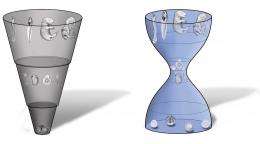Figure 1: The funnel-like model (left) and the hourglass model (right) are two competing theories that explain how developmental processes are conserved during evolution. In the funnel-like model, conservation occurs at the earliest embryonic stage (bottom) but in the hourglass model it occurs during the middle. Credit: 2011 Naoki Irie and Shigeru Kuratani
Nearly 150 years ago, noted German biologist Ernst Haeckel made the bold assertion that ‘ontogeny recapitulates phylogeny’: in other words, morphological changes that occur during an organism’s embryonic development mirror its evolutionary history.
This concept has long since been debunked, but has nevertheless provided useful starting points for considering the yet-unsolved question of how the developmental process has evolved. Naoki Irie of the RIKEN Center for Developmental Biology (CDB) in Kobe has pondered this problem since graduate school. “My main interest then and now has been to understand the basic or common rules of how animal bodies develop,” he says.
Now, as a postdoctoral fellow in Shigeru Kuratani’s laboratory at CDB, Irie has conducted an ambitious comparative analysis of four vertebrate species with the aim of resolving an ongoing debate over two prevailing evolutionary models1 (Fig. 1). The ‘funnel-like’ model, informed in part by Haeckel’s thinking, suggests that the process of vertebrate embryonic development is very similar across species at the earliest stages, but increasingly differs at later stages. In contrast, the ‘hourglass’ model suggests that the earliest and latest stages of development differ considerably, whereas the greatest similarity is observed at the intermediate stages where organ development and body patterning take place.
To resolve this so-called ‘evo-devo’ debate, Irie and Kuratani analyzed changes in expression levels of thousands of evolutionarily conserved genes at different developmental points in the mouse, chicken, frog and zebrafish. The data provided striking support for the hourglass model, with gene transcription levels most similar at the intermediate stage known as ‘pharyngula’, where the animal has developed primitive precursors of the heart, kidney, brain and other tissues. They observed particularly strong conservation of activity among the Hox genes, which contribute to limb development, as well as several growth factor genes.
These findings offer new fuel for the evo-devo debate, but also raise complicated questions. “It is puzzling for me how vertebrate embryos established differences in early developmental stages while conserving the mid-embryonic stages,” says Irie. “It’s obvious that later developmental stages will not exist if earlier stages fail to develop successfully.”
Irie now hopes to obtain further support for the hourglass model by expanding his approach to include well-characterized invertebrate species, such as the fruit fly. He also intends to dig deeper into the nuts and bolts of development. “We would like to go down to the level of tissues and primordial organs to find which structures have been conserved during evolution,” he says.
More information: Irie, N. & Kuratani, S. Comparative transcriptome analysis reveals vertebrate phylotypic period during organogenesis. Nature Communications 2, 248 (2011). doi:10.1038/ncomms1248
Provided by RIKEN























